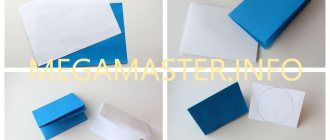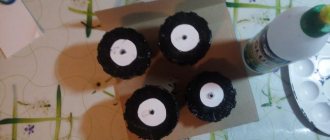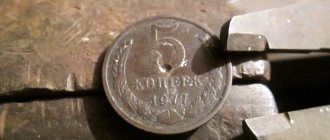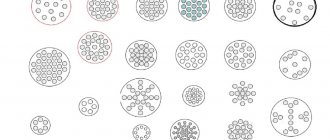Wood and epoxy seem to have been created for each other from the very beginning. The combination of these two materials really can produce a mesmerizing effect. Jewelry lovers probably know about this, thanks to numerous photos of homemade wooden rings with epoxy resin. In addition to being beautiful, such decorations are also very simple. But only if you know a number of important subtleties in advance.
In this master class, we will step by step examine the nuances of making jewelry from epoxy: from cutting out the wooden rings themselves to directly filling them with resin. The project itself is quite simple and is intended primarily for beginners working with resin for the first time. By starting simple, you'll have a better understanding of how epoxy behaves and can easily move on to more complex designs. However, so that the project does not seem completely boring, we added a simple but expressive decorative effect to it. So let's get started.
Before you start using resin for the first time, we highly recommend reading our guide to working with epoxy. It describes in detail all the pitfalls that beginners encounter, indicates the causes of the most common defects, and gives important recommendations for working with this not the safest material.
How to make a beautiful ring from wood and epoxy resin
To make beautiful wooden rings with epoxy resin, you should purchase jewelry (decorative) resin for the work. Epoxy is divided into two types: structural and decorative. Structural is used in industry, it is toxic and has a sharp, unpleasant odor. And the jewelry substance is used specifically to create beautiful jewelry.
After curing, the decorative epoxy becomes completely transparent. This quality allows you to use various additional inclusions during work, as well as paint the substance in any color.
Epoxy resin is great for decorative work
What you need
To make a beautiful ring from wood and epoxy resin with your own hands, you first need to prepare both the work surface and the necessary tools. For the creative process you will need the following:
- epoxy resin and hardener (a catalyst is often included with the epoxy);
- containers for mixing substances;
- a spatula or long wooden skewer for mixing materials;
- forms (molds), blanks into which epoxy will be poured;
- tools for finishing: polishing machine, mini-drill, jigsaw (needed for processing large and massive rings);
- polishing paste;
- dyes (if the design includes multi-colored products);
- fine-grained sandpaper.
Preparation for production
Before studying the instructions on how to make a ring from epoxy resin, you need to decide on its design. You can use wood, sparkles, dried flowers, rhinestones, beads, etc. as additional accessories. The necessary tinting dyes are also prepared.
Step-by-step work guide
To correctly approach the creation of a beautiful epoxy ring, follow these simple instructions. The work is carried out in the following stages:
- Design elements are placed into forms. The mold is installed strictly horizontally - this is necessary for complete filling.
- The hardener is carefully and slowly added to the resin. The proportions should be observed according to the instructions. In the classic form, 1 part of hardener is added to 10 parts of resin. At the same time, the necessary dye is included in the mass.
- The viscous mass is slowly poured into the mold. When pouring, the substance must be mixed so that the resin completely fills the entire workpiece.
- After pouring is completed, the mold is left at room temperature until complete polymerization. This usually takes 1–1.5 days.
- The finished ring is removed from the mold. Now comes the finishing stage. The product is ground and polished to give it an ideal shape and mask imperfections.
The finished product must be processed and polished
Advice. Not every dye is suitable for working with a substance such as epoxy. For such creativity, special epoxy pigments are used. You can also use stained glass dyes, nitro dyes, pastel, oil paints and inks for color laser printers.
When working with a resinous substance, you should also follow some useful tips. Namely:
- the hardener has a shelf life (1 year), after which it loses its properties;
- It is necessary to store epoxy at a temperature of +15–25⁰С (when the temperature drops, the mass crystallizes);
- the prepared mass (resin + hardener) should be used immediately;
- the polymerization process requires air;
- the maximum permissible thickness of one layer of resinous substance should not exceed 5 cm;
- repeated layers are poured only after the previous ones have completely hardened;
- polymerization of the product occurs within 1–1.5 days.
How to cover a wooden ring?
The final chord is the application of decorative finishing. For these purposes, it is better to use colorless coatings that do not form a film - they are easier to apply, they are more beautiful and retain the tactile texture of the wood. In our case, we used linseed oil - read more about the intricacies of its application here. Finishing with other oils (tung, teak, Danish) or wax will look no less impressive. To imitate valuable species, for example, dark wood, stain is used.
Having developed this technology and learned how to create wooden rings of simple shapes, you can move on to more complex and interesting designs.
Methods for making wooden rings
A DIY wooden ring will most likely be made by cutting. That is, a prototype ring is cut out of a wooden blank using a cutting tool, the central part is selected (with a crown or drill) and the surfaces are processed manually (with sandpaper) or using grinding equipment.
There is an alternative way to make rings - bending. The blank for bending is a strip of wood approximately the width of the future ring. The wood is artificially softened (usually by wetting) and bent into a ring. This method allows you to obtain exquisite jewelry with an original texture, but it is quite complex and difficult to implement at home.
Wooden wedding rings made by a true craftsman are outstanding works of decorative and applied art. This is a wonderful gift for a married couple for a wooden wedding - their fifth anniversary of marriage. But some newlyweds also choose them as their main wedding rings.
Rings are often made from different types of wood, differing in color and texture. To do this, wooden blanks are pre-glued and then worked as if they were a solid solid.
Stages
Making jewelry from epoxy resin with your own hands is a labor-intensive and painstaking process. In order for the finished product to turn out beautiful and original, you should adhere to the manufacturing scheme.
Stage 1
Place pieces of wood and other decor (broken shells, pebbles, metal elements) into the prepared form. The arrangement of elements depends on the idea.
Stage 2
Preparation of plastic surgery. Remember, you need to work in a well-ventilated area. In a plastic container, mix the resin and hardener (they are marked with the letters A and B, respectively). Strictly follow the proportions specified by the manufacturer. The mixing process takes up to 15 minutes. At this stage you should add dye. For uniform coloring, the pigment is added to substance A, then mixed with the hardener.
The finished mixture becomes viscous and homogeneous. If your consistency is too runny, leave the mixture for 30-40 minutes. During this time it will become thicker. There should be no air bubbles in the finished plastic. Otherwise, when grinding, indentations will appear on the surface of the product.
Stage 3
Pouring the workpiece. The form should be on a flat surface. If you use molds, do not allow plastic to leak over the edge. Leave the workpiece for a day in a ventilated area.
Stage 4
Creating a decoration form. From the frozen blank, you can create wooden rings with epoxy resin in various shapes. To obtain a product of a standard shape, first drill out the blank using a crown attachment. It is better to drill through the workpiece to make it easier to work on the inner diameter of the ring.
To make a ring, use a jigsaw or file to cut out a rectangular blank. Use a drill to drill a hole in the desired location. Then clamp the workpiece in a vice and cut off the excess. The size of the internal diameter is increased using a cutter. If you do not have such an attachment, this can be done using sandpaper twisted into a tube.
Those who use molds immediately receive decoration of the desired shape. Therefore, they can proceed to grinding.
Stage 5
Grinding and polishing. Now the workpiece should be sanded. Sand the epoxy resin and wood ring using sandpaper, starting with the coarsest sandpaper and working your way down to the finest sandpaper. If you need to remove a lot of unevenness, start with sandpaper P80-P120. At this stage, you can give the ring any shape or make edges. When sanding, it is better to wear a mask or respirator, since processing produces a lot of dust. To avoid injuring your hands on the sandpaper, wear gloves.
You can polish the finished product on a polishing wheel or with a special attachment for a drill, using polish or paste. Your decoration is ready.
Making jewelry from plastic takes 3-4 hours of pure work, but if you take into account the hardening time, the creation process will take about 48 hours. In this way you can make an original wooden ring with beads, ornamental stones, flowers and leaves.
Preparation for production
It is better to use a separate table for making jewelry. If this is not possible, a tray or large wooden board can serve as a work surface. Silicone molds need to be washed and dried. If molds made of other materials are used during work, they need to be covered with tape or cling film and greased with Vaseline.
Decide on the decoration design in advance. Prepare wood and other decorative materials (glitter, plant parts, dyes). To make the transition border between plastic and wood look original, you can break a board or prepare a cutting line with a jigsaw.
Kinds
Jewelry made from epoxy resin surprises with its variety. Despite the fact that the general manufacturing technology remains the same, making some adjustments allows you to achieve a truly unique look.
Epoxy rings are surprisingly smooth and even, but they can also be versatile:
- transparent without patterns;
- multi-colored;
- interspersed with shavings;
- with dried flowers;
- half made of wood.
These are just the types of rings that are most commonly found. The ring can also be ordinary jewelry, and only a “pearl” is made of epoxy resin.
Expert opinion
Oleg Vasiliev
Master of making furniture and interior items from epoxy resin. She creates unique items to order in her own production.
Ask a question to the master
The main requirement for fillers for products and wooden parts is that they must be completely dry. Even a small amount of moisture will cause the product to become cloudy from the inside. In dried form, any materials can be used, even organic materials, for example, insects to imitate amber.
DIY rings photo
A button ring is another fashion idea.
Options for making paper rings can be the most unusual.
Even such a prosaic element as a nut can become a unique accessory.
Flexible and pliable wire opens up scope for any imagination.
A bright and sparkling beaded ring will make its owner even more dazzling.
Wooden rings can be decorated with delicate lace braid.
Rings in the form of plastic sweets look playful and unusual.
And this ring is made from a regular zipper.
Making a ring
Making a ring from a coin using this method is quite difficult. In words, everything looks simple: you need to drill a hole of small diameter, then unfold the workpiece through a cone to the desired size and finally polish it. In practice, everything turns out to be somewhat more complicated.
In order not to describe the entire process of making a ring with your own hands, a video will be attached below in which everything is shown in great detail.
What is epoxy resin?
From a chemical point of view, epoxy resin is a synthetic compound. This material is used in various industries and households. Pure resin is usually not used; it can harden when combined with a hardener, that is, a polymerization reaction occurs.
If you combine different types of resin and hardener, you can end up with products of varying hardness that are hard and durable or flexible like rubber.
Epoxy resin is resistant to alkalis, acids and water, it can dissolve in acetone without creating a film. Hardener-based epoxy material is not capable of releasing volatile compounds, and it shrinks slightly.
Summary
It is quite possible to create exclusive jewelry with your own hands. A little patience, perseverance, imagination and you will become the owner of a unique ring, bracelet or pendant. Products made of epoxy resin in combination with wood will complement your everyday look, fit harmoniously into the office style and make it more feminine. If you add a little glitter or stones to the plastic, the jewelry will go perfectly with an evening outfit.
Types of Epoxy Resin Rings
There is no categorization of jewelry as such. But craftsmen can add various additional materials to epoxy rings:
- Rhinestones, sparkles, beads.
- Dried flowers, leaves, spruce needles.
- Wooden fragments.
- Dried insects.
- Phosphor for luminous products.
The above list is only an example. Each craftsman independently selects additional materials for making accessories.
Most often on the market you can find a wooden ring with epoxy resin. The decoration can be made in two versions. In the first case, fragments of material are simply added to the liquid resin to form a pattern. In the second, craftsmen initially make a wooden ring, which is then framed with a layer of epoxy.
No less popular is a resin ring with flowers. Since this accessory is small, real petals are rarely used in its production. More often these are simply drawings made from the same resin or pre-made figures from clay and other materials.
Glowing epoxy rings look quite interesting. To obtain the effect, a special material is added to the liquid resin - a phosphor. With its help you can make multi-colored products that will glow in the dark.
However, such jewelry is better suited for experienced craftsmen. Beginners are recommended to first try their hand at regular models without additives.
Tools
To make a ring from wood and epoxy resin you will need:
- containers for making plastic;
- mixing sticks;
- molds - silicone blanks, suitable for rings with wood shavings;
- a jigsaw or band saw - will be needed to create more massive and complex products;
- mini-drill with roller attachments of different diameters, including grinding attachments;
- sandpaper with grit P150-P2500;
- polishing paste.
What is an epoxy resin hardener?
The component that leads to the polymerization reaction is called a hardener. If you combine different types of resin and hardener, then using an epoxy composition you can obtain special compositions.
Tertiary amines, phenols and other similar elements are used as hardeners. The amount of hardener added depends on the composition of the epoxy resin. The polymerization reaction is irreversible, that is, after hardening, the resin cannot be melted.
If there is not enough hardener or it is excess, then the composition changes its qualities, it may lose strength, resistance to high temperatures, chemical elements, and water. If there is not enough hardener, the product will stick because the resin has not set. And over time, excess hardener appears on the surface of the product. The correct ratio of resin and hardener should be indicated on the packaging of the materials.
You might think that if more hardener is added, the resin will harden faster, but this is a mistaken opinion. In order for the mixture to harden faster, it is necessary to raise the temperature by 10 degrees. This will help the prepared mixture harden 3 times faster. The rate of hardening is influenced by temperature and the type of hardener.
What kind of wood can a ring be made from?
When making a ring, it is very important to choose the right material. It should be moderately hard, have a beautiful texture and a pleasant shade. The following types of wood are best suited:
- Oak _ The material has a rich palette of shades - from light to dark brown, and a porous but hard texture. It is practically not subject to rotting.
- Rosewood . Expensive and beautiful wood, ideal for making jewelry. It has a pleasant dark color with beautiful veining.
- Walnut . This is an affordable material with a grayish tint that can be easily processed.
- Bird cherry . It has a red-brown color with dark veins and lends itself well to coloring.
- Karelian birch . This wood is quite expensive. But at the same time, the products are very durable and have a beautiful texture with orange-brown stains.
- Aspen . A very soft and flexible material that is good for manual processing.
- Rowan . It has a fairly light, practical white color.
- Wild apple tree . This wood has a beautiful texture with clear brown veins.
Important! A cultivated apple tree does not have such properties.
You can also use white or black hornbeam, amaranth, sycamore, pear, linden, and cherry. The most valuable are the roots and growths (burls), which have a special texture and color. The more expensive the chosen material, the more valuable the decoration is.
The process of making a pendant and ring
First, we need a mold from which the workpiece can be easily removed. For this we will use tape and, for example, a phone battery. Additionally, we will take a piece of plastic that we will use as a base.
Select the size of the mold taking into account the fact that the workpiece will then need to be sanded and polished. First of all, wrap the battery with the back side of the tape, and then sticky tape on top. Carefully remove the battery. We glue the finished form to the plastic using epoxy resin.
If you want to get a finished product right away without any special processing, then use something appropriate as a mold. Next, mix the epoxy resin with the hardener - you can use a plastic fork and a screwdriver for this. Add a little dye.











